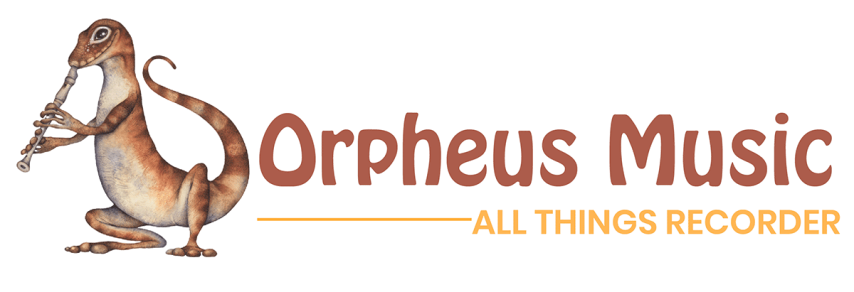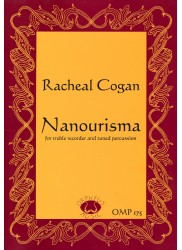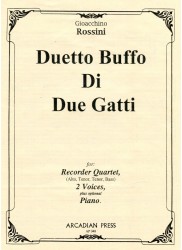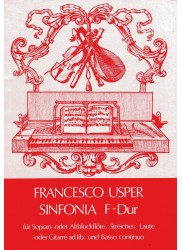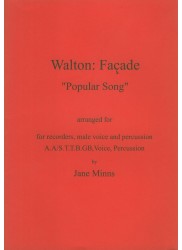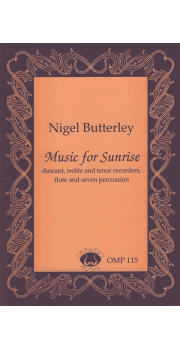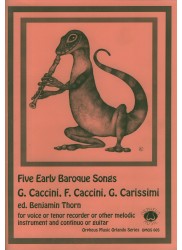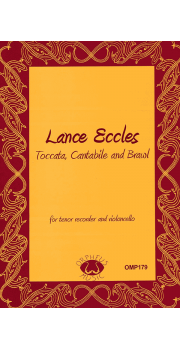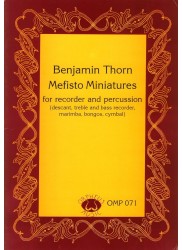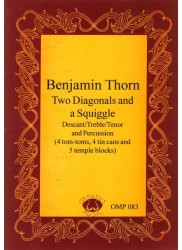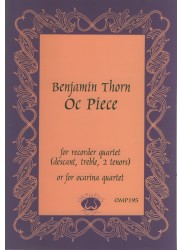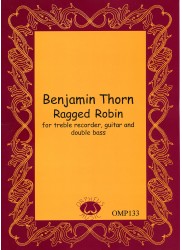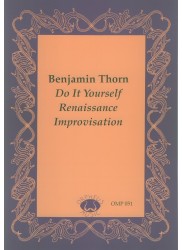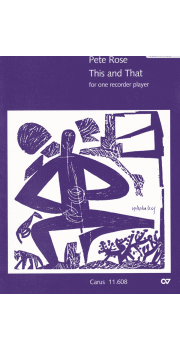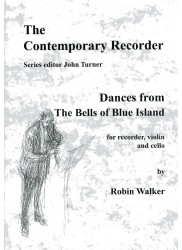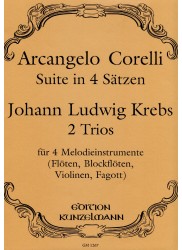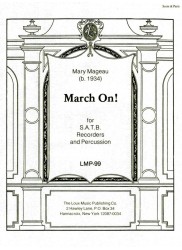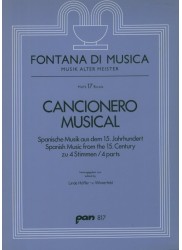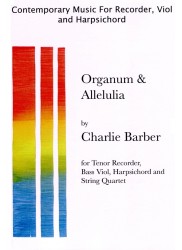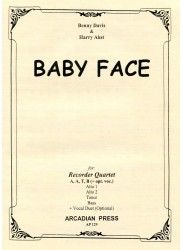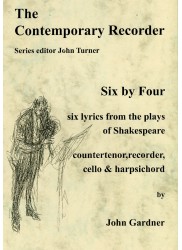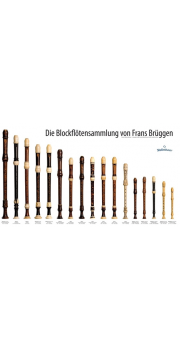No products
Prices are tax included
Nanourisma
OMP175.pdf
PLEASE NOTE - DOWNLOADABLE PDF VERSION
Composer: Cogan - Racheal
Instrumentation: Treble + tuned Percussion (gongs in C - F + C; temple bell in G; 5 bells roughly G - D)
Period/genre: Australian Contemporary
Grade: Difficult - Very Difficult
More info
*Contemporary Piece.* Ethereal filigree work based on a Greek lullaby. Some beautiful sound combinations including use of voice.
Please note that due to the automated delivery of virtual products including pdf downloads, PayPal payment is required at the checkout - we are unable to accept the cheque payment method for these items.
_Score 4 pp. 2 x Copies. Downloadable PDF file._
NANOURISMA, BY RACHEAL COGAN.
OMP175, 2008. A + singing & tuned perc (gongs in C, F & C,
temple bell in G,5 bells abt. G-D). 2 sc, 4 pp ea + instructions/notes.
Nanourisma ("lullaby" in Greek) was recorded by Racheal Cogan, playing recorder and singing, with Tony Lewis, percussion, on their 2006 CD Transcience: contemporary modal music Orpheus Music OM602; see the CD review in AR, September 2008).
It is a rich, soft, dark-timbred piece likely to evoke a dream sense for many players and listeners. The
piece is difficult, though very effective and within the grasp of a recorderist who has learned to hold a sung note while playing related pitches. The slow tempo (-50) is, as the composer comments, "quite rhythmically free."
The demands on both players are in the area of musicianship rather than virtuosic technique. The played
notes for the alto range from F at the bottom of the treble staff up to B a fourth above the treble staff. Fingerings for trills and simpler ornaments are explicitly indicated in the score. The sung notes are slow-moving and primarily provide a drone. In her introduction to the piece, Cogan describes options for performance; between her comments and listening to the recording, plus my own experiments in playing the piece, I find that it is necessary for the recorder and voice to be in the same pitch relationship as indicated in the P1 score. (Some other pieces, in which the player sings simultaneously while playing, work with the voice at either the notated octave or an octave below.) This makes the piece better suited for women performers than men, but Cogan suggests experimentation with instruments to get that desired effect. I tried the piece with tenor recorder fingered as an alto, which placed it low enough that I (a bass/baritone) could sing in the appropriate octave.
It is important to note that the piece can be performed with or without percussion with Cogan's blessing.
However, if percussion is used, the pitches are critical, and the tuning of the gongs and bells needs to closely match the score. Thus if one transposes the recorder part's range, the percussion must also be transposed Cogan's Nanourisma is a beautiful and satisfying work. Learning it will strengthen one's technique in simultaneous singing and playing. The composer provides a readable, performable
score with flexibility to suit a variety of players. Orpheus Music provides a well-printed edition. This reviewer worked from the hard copy printed by Orpheus, though the same edition can be downloaded at a reduced cost.
Composer/performer Tom Bickley (vocals, recorders, electronics) is Ars CD Reviews Editor. His degrees are in liturgy, information science and music, Gregorian chant, other Medieval music, and African American sacred music).
American Recorder Summer 2015
30 other products in the same category:
Reference: AP048
Brand: Arcadian Press
Duetto Buffo di due Gatti
Composer: Rossini - GioacchinoInstrumentation: Treble - 2 Tenors - Bass +...
In StockReference: 5144
Brand: Fidula
Sinfonia in F Major
Composer: Usper - FrancescoArranger: Peter ThalheimerInstrumentation: Treble...
In StockReference: P251
Brand: Peacock Press
Facade: Popular Song
Composer: Walton - WilliamArranger: Jane MinnsInstrumentation: Treble -...
In StockReference: FZZ01
Brand: Forsyth
A Birthday Album for the Society of Recorder Players
Composer: Various Instrumentation: Various Combinations of Recorders - some...
In StockReference: OMP115
Brand: Orpheus Music
Music for Sunrise
Composer: Butterley - Nigel Instrumentation: Descant - Treble - Tenor +...
In StockReference: OMOS005
Brand: Orpheus Music
Five Early Baroque Songs
Composer: Caccini - Carissimi Arranger: Benjamin Thorn Instrumentation:...
In StockReference: OMOS005.pdf
Brand: Orpheus Music
Five Early Baroque Songs
PLEASE NOTE - DOWNLOADABLE PDF VERSION Composer: Caccini - Carissimi...
$29.50 -20%In StockReference: OMP175
Brand: Orpheus Music
Nanourisma
Composer: Cogan - Racheal Instrumentation: Treble + tuned Percussion (gongs...
In StockReference: OMP179
Brand: Orpheus Music
Toccata, Cantabile and Brawl
Composer: Eccles - Lance Instrumentation: Tenor + Violoncello Period/genre:...
In StockReference: OMP179.pdf
Brand: Orpheus Music
Toccata, Cantabile and Brawl
PLEASE NOTE - DOWNLOADABLE PDF VERSION Composer: Eccles - Lance...
$17.50 -20%In StockReference: OMP180
Brand: Orpheus Music
Codex Snaviensis 1
Composer: Evans - Winsome Arranger: Benjamin Thorn Instrumentation: Various...
$31.00 -30%In StockReference: OMP071
Brand: Orpheus Music
Mefisto Miniatures
Composer: Thorn - BenjaminInstrumentation: Descant - Treble - Bass +...
In StockReference: OMP071.pdf
Brand: Orpheus Music
Mefisto Miniatures
PLEASE NOTE - DOWNLOADABLE PDF VERSION Composer: Thorn -...
$19.00 -20%In StockReference: OMP083
Brand: Orpheus Music
Two Diagonals and a Squiggle
Composer: Thorn - Benjamin Instrumentation: Descant - Treble - Tenor -...
In StockReference: OMP083.pdf
Brand: Orpheus Music
Two Diagonals and a Squiggle
PLEASE NOTE - DOWNLOADABLE PDF VERSION Composer: Thorn - Benjamin...
$26.50 -20%In StockReference: OMP195
Brand: Orpheus Music
Oc Piece
Composer: Thorn - BenjaminInstrumentation: Descant - Treble - 2...
In StockReference: OMP133
Brand: Orpheus Music
Ragged Robin
Composer: Thorn - Benjamin Instrumentation: Treble - Guitar + Double Bass...
In StockReference: OMP133.pdf
Brand: Orpheus Music
Ragged Robin
PLEASE NOTE - DOWNLOADABLE PDF VERSION Composer: Thorn - Benjamin...
$28.00 -20%In StockReference: OMP051
Brand: Orpheus Music
Renaissance Improvisation
Composer: Various Arranger: Benjamin Thorn Instrumentation: Various...
In StockReference: OMP051.pdf
Brand: Orpheus Music
Renaissance Improvisation
PLEASE NOTE - DOWNLOADABLE PDF VERSION Composer: Various Arranger:...
$17.50 -20%In StockReference: 11.608
Brand: Carus
This and That
Composer: Rose - Pete Instrumentation: Descant - Sopranino + Voice...
In StockReference: PJT113
Brand: Peacock Press
Dances from The Bells of Blue Island
Composer: Walker - Robin Instrumentation: Sopranino + Violin and Cello...
In StockReference: GM1267
Brand: Edition Kunzelmann
Suite in 4 movements/2 Trios
Composer: Corelli/Krebs Instrumentation: 4 Melody Instruments (Flute -...
In StockReference: P545
Brand: Peacock Press
Tourdion, Variations on a traditional tune
Composer: Blondeau - Pierre Arranger: Sue Handscombe Instrumentation:...
In StockReference: LMP99
Brand: Loux Music Publishing
March On!
Composer: Mageau - MaryInstrumentation: Descant - Treble - Tenor - Bass +...
In StockReference: PAN817
Brand: Pan
Cancionero Musical, Spanish Music from the 15th Century
Composer: Various Arranger: Linde Hoffer & V Winterfeld Instrumentation:...
In StockReference: P580
Brand: Peacock Press
Organum & Allelulia
Composer: Barber - Charlie Instrumentation: Tenor + Bass Viol - Harpsichord...
In StockReference: AP129
Brand: Arcadian Press
Baby Face
Composer: David/Akst - Benny/Harry Arranger: Stan Davis Instrumentation: 2...
In StockReference: PJT112
Brand: Peacock Press
Six by Four
Composer: Gardner - JohnInstrumentation: CounterTenor - Treble Recorder +...
In StockReference: MOL-6186
Brand: Mollenhauer
Poster Die Blockflotensammlung von Frans Bruggen
Poster Die Blockflotensammlung von Frans Bruggen Poster of Recorder...
In Stock
